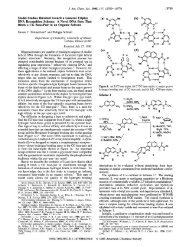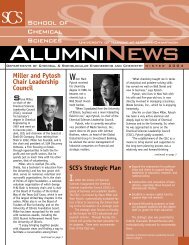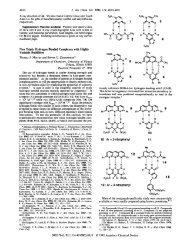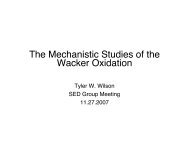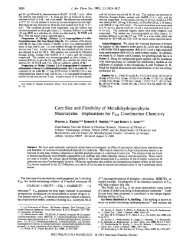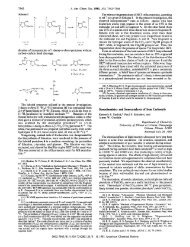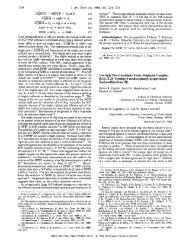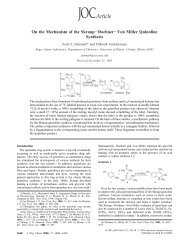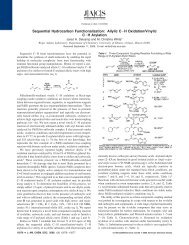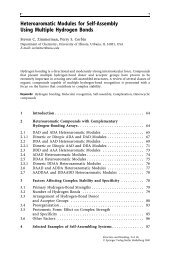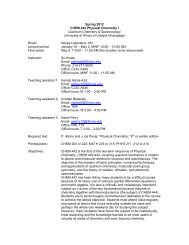J. Am. Chem. Soc., 1996, 118, 11960-11961. - School of Chemical ...
J. Am. Chem. Soc., 1996, 118, 11960-11961. - School of Chemical ...
J. Am. Chem. Soc., 1996, 118, 11960-11961. - School of Chemical ...
You also want an ePaper? Increase the reach of your titles
YUMPU automatically turns print PDFs into web optimized ePapers that Google loves.
Communications to the Editor J. <strong>Am</strong>. <strong>Chem</strong>. <strong>Soc</strong>., Vol. <strong>118</strong>, No. 47, <strong>1996</strong> 11961<br />
Figure 3. Magnetization hysteresis loops for the nanometer iron<br />
particles dispersed in a PVP matrix at 250 K: (+) magnetization data<br />
points; (9) demagnetization points. No hysteresis is observed and<br />
consequently the magnetization data points are overlapped by the<br />
demagnetization data.<br />
Figure 2. Transmission electron micrograph <strong>of</strong> sonochemically<br />
prepared iron colloid particles (with average particle size <strong>of</strong> 8 nm)<br />
stabilized by oleic acid.<br />
colloid particles were slightly larger than the PVP colloid but<br />
much more uniform, with average particle size <strong>of</strong> 8 nm (Figure<br />
2). The electron microdiffraction after in situ crystallization<br />
showed that oleic acid particles are a mixture <strong>of</strong> Fe and FeO.<br />
When the particles <strong>of</strong> ferro- or ferrimagnetic materials are<br />
smaller than the dimensions <strong>of</strong> a single domain (which for Fe<br />
and Co is ≈20 nm), thermal fluctuations will supersede the<br />
Weiss anisotropy above the blocking temperature. Such<br />
particles are called superparamagnetic. 24 An operational definition<br />
<strong>of</strong> a superparamagnetism has two requirements. First, the<br />
plot <strong>of</strong> magnetization (M) vs applied magnetic field (H) must<br />
show no hysteresis. Second, the magnetization <strong>of</strong> an isotropic<br />
sample at different temperatures must superimpose when plotted<br />
against H/T, after correction for the temperature dependence <strong>of</strong><br />
the spontaneous magnetization. Sonochemically synthesized<br />
nanosized iron particles show no hysteresis in their magnetization<br />
data at 290 K (Figure 3). 25 Furthermore plots <strong>of</strong> magnetization<br />
vs (magnetic field)/(temperature) for the Fe/PVP sample<br />
at 290, 250, and 200 K (Figure 4) superimpose after correction<br />
for the temperature dependence <strong>of</strong> the spontaneous magnetization.<br />
Thus, sonochemically prepared nanometer Fe colloids are<br />
superparamagnetic.<br />
High saturation magnetization is desirable for magnetic fluid<br />
application and is highly sensitive to the method <strong>of</strong> preparation.<br />
The saturated magnetization (M s ) <strong>of</strong> the initially prepared PVP<br />
colloidal nanometer Fe particles is a respectable 101 emu/g (Fe)<br />
at 290 K. M s is determined by extrapolating the experimental<br />
plot <strong>of</strong> M vs 1/H using data at high magnetic fields. Standard<br />
crystalline bcc Fe has a saturated magnetization <strong>of</strong> 222 emu/g<br />
(Fe) at 298 K, 26 whereas bulk amorphous Fe saturates at 156<br />
(24) Jacobs, I. S.; Bean, C. P. In Magnetism III; Rado, G. T., Suhl, H.,<br />
Eds.; Academic Press: New York, 1963; pp 271-351.<br />
(25) Magnetic studies were conducted with a Quantum Design MPMS,<br />
7 T, SQUID magnetometer. Colloidal iron samples were loaded into gelatin<br />
capsules inside an inert atmosphere box, carried to the magnetometer under<br />
inert atmosphere, and rapidly transferred to the sample chamber. All<br />
magnetic data have been corrected for the diamagnetism <strong>of</strong> the gelatin<br />
capsules, solvents, and colloid stabilizers.<br />
(26) Cullity, B. D. Introduction to Magnetic Materials; Addison-Wiley:<br />
New York, 1972; pp 171-190.<br />
Figure 4. Magnetization (M) versus magnetic field/temperature (H/<br />
T) at(9) 200 K, (+) 250 K, and (]) 290 K, after correcting for the<br />
temperature dependence <strong>of</strong> spontaneous magnetization (I s/I o) for the<br />
nanometer iron colloid particles dispersed in a polyvinylpyrrolidone<br />
matrix.<br />
emu/g (Fe). 21 The saturation magnetization <strong>of</strong> our sonochemically<br />
prepared iron colloid is greater than that <strong>of</strong> solvated<br />
nanometer-scale iron particles produced by metal vapor deposition<br />
(55 emu/g (Fe) at 55 kOe) 27 or ion-exchange resin stabilized<br />
nanocrystalline γ-Fe 2 O 3 (99 emu/g at 10 kOe), 28 but smaller<br />
than those <strong>of</strong> copoly(styrene-butadiene)-stabilized iron colloids<br />
(120-170 emu/g (Fe) at 10 kOe). 14 For a comparison, the<br />
saturation magnetization <strong>of</strong> a commercial magnetite-based<br />
magnetic fluid is 123 emu/g (Fe). 29<br />
In conclusion, a simple synthetic method has been discovered<br />
to produce nanosized iron colloid using high-intensity ultrasound.<br />
Nanometer iron particles dispersed in polyvinylpyrrolidone<br />
(PVP) matrix or stabilized by adsorption <strong>of</strong> oleic acid have<br />
been synthesized by sonochemical decomposition <strong>of</strong> Fe(CO) 5 .<br />
Transmission electron micrographs show that the iron particles<br />
have a relatively narrow range in size from 3 to 8 nm for<br />
polyvinylpyrrolidone, while oleic acid gives an even more<br />
uniform distribution at 8 nm. Magnetic measurements revealed<br />
that these nanometer iron particles are superparamagnetic with<br />
a saturation magnetization <strong>of</strong> 101 emu/g (Fe) at 290 K. This<br />
work is easily extended to colloids <strong>of</strong> other metals and to alloys<br />
<strong>of</strong> two or more metals, simply by using multiple volatile<br />
precursors. For example, we have recently made nanostructured<br />
Fe/Co alloys sonochemically. 20 Controlled reaction with O 2 or<br />
other oxidants will also permit the formation <strong>of</strong> transition metal<br />
oxide colloids.<br />
Acknowledgment. We gratefully acknowledge Pr<strong>of</strong>essor Myron<br />
B. Salamon for many helpful discussions. This work was supported<br />
by the NSF (DMR-8920538 and CHE-9420758). For electron microscopy,<br />
we thank the assistance <strong>of</strong> the UIUC Center for Microanalysis<br />
<strong>of</strong> Materials. supported by the DOE.<br />
JA961807N<br />
(27) Kernizan, C. F.; Klabunde, K. J.; Sorensen, C. M.; Hadjipanayis,<br />
G. C. <strong>Chem</strong>. Mater. 1990, 2, 70.<br />
(28) Ziolo, R. F.; Giannelis, E. P.; Weinstein, B. A.; O’Horo, M. P.;<br />
Ganguly, B. N.; Mehrotra, V.; Russell, M. W.; Huffman, D. R. Science<br />
1992, 257, 219.<br />
(29) Ferr<strong>of</strong>luids Corporation, catalog no. APG 047. Magnetite (Fe 3O 4)<br />
is dispersed in hydrocarbon with an aromatic amine as stabilizer (12.3 wt<br />
% <strong>of</strong> Fe).



